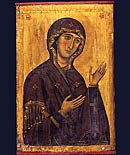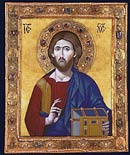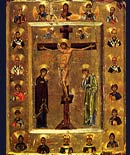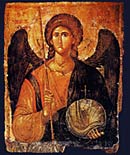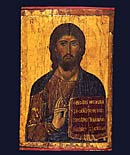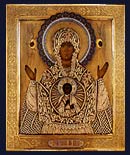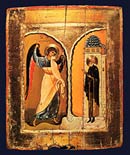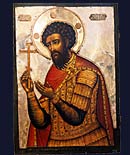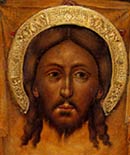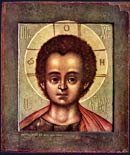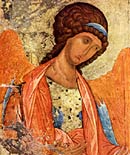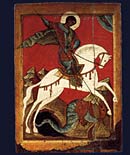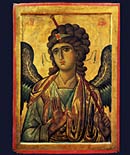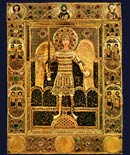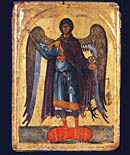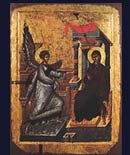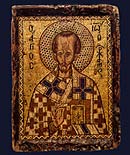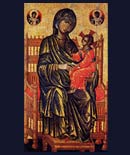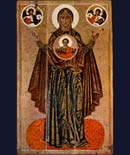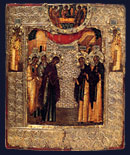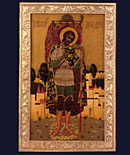Ikon History - Ikons of Mary, the Theotokos
The appellation for Mary of Theotokos, or Mother of God, became widespread in the Christian Church much earlier than the fifth century, when a council of the entire church at Ephesus made the title official. This ikon of Mary holding the infant Christ in her arms is a copy of the famous ikon of the Hodegetria or "Indicator of the Way", in which she points toward her Son as the path of salvation. The Hodegetria ikon was very popular throughout the Christian Church and was, perhaps, the most widely reproduced ikon type of the Madonna in the Orthodox world.
Written records for the early history of the ikon are scarce. A long tradition associated with the ikon must have existed at least as early as the 4th century. The Hodegetria ikon was installed by the Empress Pulcheria in the mid-fifth century in a sanctuary (Theotokos ton Hodegon) she founded on a terrace overlooking the sea in the area of the Great Palace, which was in the eastern part of Constantinople. The sanctuary was alongside a sacred font. Later a monastery was erected beside the shrine of the ikon. Foundations of the sacred font, which is on two levels and fronted by a semi-circular colonnade, is all that is to seen of the church complex, although excavations about 10 years ago which seemed to be revealing more of it.
The church and the ikon were very popular and miraculous healings, most frequently of the blind, took place at the hagiasma (well or holy font).
The ikon was always associated with St. Luke and was said to be large, square, measuring six palms high and highly ornamented - probably by a cover in precious metals and stones. The back of the ikon had an image of the Crucifixion. Relics of St. Luke and a St. Symeon were said to have also kept at the church. Other relics of the Theotokos were kept at the church, as well.
In the later period (perhaps this was an very old tradition) the ikon was displayed or processed every Tuesday around the monastery. The whole city was said to be there. There was beautiful singing in front of the ikon and people were deeply moved - one Orthodox traveller from Novgorod says people wept in front of her. Flabella were carried in front of the ikon and there was a canopy carried by attendants. People were anointed with chrism on cotton balls from the ikon. There was also a special confraternity of men (all, it is said, from the same family) who carried the ikon on Tuesdays. The men were blindfolded with a special hait of red linen covering their faces and the ikon would miraculously direct them where to carry her around the monastery. While this happened the people sang a very long chant, which included "Lord have mercy".
The ikon frequently and regularly travelled away from it's shrine. During the Commenian period the ikon was brought every Friday to the Pantokrator Monastery, near the center of the city. A special church, dedicated to the ikon had been built there. The ikon was saved by the people of Constantinople during the Latin sack of the City by the Fourth Crusade in 1204, but ended up in the hands of Venetians, who stole it from the Latin Patriarch of the City and then kept it at the Imperial Monastery of the Pantokrator, which had been seized and converted to the Catholic rite. On the Thursday before Palm Sunday it was taken to the Imperial Palace and stayed there until Easter Monday. The ikon also appears to have visited the Palace every Saturday as it left the Pantokrator on the way back to the Hodegon. There are also texts which tell us that the ikon was sometimes taken to Hagia Sophia - which was fairly close to the Hodegon.
The ikon was carried about the walls of the city in times of trouble and it was in the Chora Church near the walls at the time of the fall of the City to the Turks. Immediately upon the fall of the City on Tuesday, May 29, 1453, the Islamic army headed directly for the Chora where they first despoiled the painting of its silver gilt mount and precious stones, before barbarously splitting the millennium-old ikon and smashing its remnants to bits.
Something of the rich cover of the ikon can be imagined looking at the Russian oklad at left, which comes from a Russian copy of the Hodegetria. Below it is a variant of the Hodegetria called "Soteria" and below it is another Russian variant called "Smolenskaya".
Next chapter: Our Lady of Kazan
